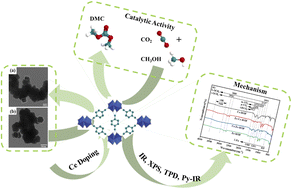Enhanced transformation of CO2 over microporous Ce-doped Zr metal–organic frameworks†
Abstract
Metal–organic frameworks (MOF) have been studied extensively for the adsorption and catalytic conversion of CO2. However, previous studies mainly focused on the adsorption capabilities of partially or totally Ce substituted UiO-66, there are few studies focusing on transformation of the structure and catalytic activity of these materials. In this work, a series of Zr/Ce-based MOFs with UiO-66 architecture catalysts were prepared for the conversion of CO2 into value-added dimethyl carbonate (DMC). Owing to the different addition order of the two metals, significantly varied shapes and sizes were observed. Accordingly, the catalytic activity is greatly varied by adding a second metal. The different catalytic activities may arise from the different acid–base properties after Ce doping as well as the morphology and shape changes. Besides, the formation of terminal methoxy (t-OCH3) was found to be the rate limiting step. Finally, the reaction mechanism of CO2 transformation in the presence of a dehydrating agent was proposed.

- This article is part of the themed collection: 2022 RSC Advances Popular Advances Collection


 Please wait while we load your content...
Please wait while we load your content...